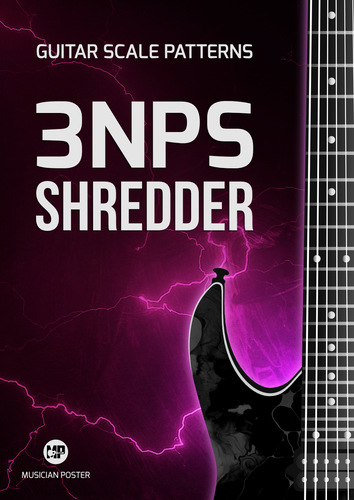In this reference chart you'll learn all 7 guitar patterns of the 3NPS system for the Harmonic Minor scale.
3NPS stands for "3-notes-per-string" and is a system of scale patterns which is often used for playing fast technical runs (commonly referred to as shredding). So if that's your current area of interest then 3NPS excels at this. Of course, you can use 3NPS to play at any speed you like, not only fast, and simply benefit from the consistent nature of this system.
Degrees formula of the Harmonic Minor scale is: 1-2-b3-4-5-b6-7.
Features and Benefits of the Chart
- Shred. A consistent system of scale patterns for the Harmonic Minor scale that allow you to play at higher speeds.
- 7 Shapes. Provides a full set of seven 3NPS shapes for the Harmonic Minor scale arranged on a single printable page.
- Diagonal. Patterns are arranged diagonally to provide a clear visualization of how they progress along the fretboard and where they line up.
- Adjacent Patterns. Includes a separate chart variation that allows you to peak into adjacent patterns without stealing focus from the pattern you are currently playing.
- From 7 Patterns to 3. To let you save time and learn even more effectively early on, four patterns are marked with an asterisk to inform you that they have too many overlapping notes and can be omitted. The remaining 3 patterns cover 95% of the fretboard.
- Movable Shapes. You can shift any shape so that its root note aligns with the root note of your choice.
- Notes As Intervals. All notes of the scale are shown as intervals (scale degrees relative to the Major scale). Having them visible instead of concrete note names allows you to target specific degrees of the scale and also easily make the necessary adjustments to the scale patterns when needed.
- Highlighted Roots. Knowing where the roots are is what differs this scale from any other scale within the same family, so it is very important to be aware of where they are in each pattern and this chart delivers.
- Scale Formula. Harmonic Minor scale degrees formula is conveniently placed right above the diagrams so that you don't need to look up another reference.
- Fret Numbers. Chart variation with fret numbers gives a little extra help in navigating the fretboard, but at the expense of consuming the precious whitespace. So if you find it distracting, a variation without fret numbers is included as well.
Example Usages of Chart Variation With Adjacent Blank Note Placeholders
Borrow Notes. You can occasionally "borrow" notes from the neighboring patterns for a brief moment and then get back to the pattern you started with. For example:
- You can perform a slide as opposed to explicitly picking the note.
- You can use tapping technique to tap the note from the adjacent pattern.
Break Free From 1 Pattern. You can get yourself prepared for switching between the patterns on the fly. This is basically a helper tool to break free from being stuck within one pattern shape.
A Map of Options. You can also think of them as a guide of where you are and where you can go.
These adjacent blank placeholders are given less emphasis on purpose—they should not distract you from the main pattern you are focusing on, but should you wish to temporarily visit (or peek into) a neighboring pattern, then you can do that.
I'm sure you can find your own application, even if it means just to observe the fretboard and how things interconnect. That is actually exactly what I'm doing here—create resources that allow you to see and learn music conveniently.
If you come up with some cool application of this chart, let me know down in the comments below, I'd be happy to read your ideas. That way you can also share your experience with the rest of the community.
Alternative scale names
Harmonic Minor is a common and popular name for the scale, but you may also find it under an alias called:
- Aeolian #7
















0 Comments